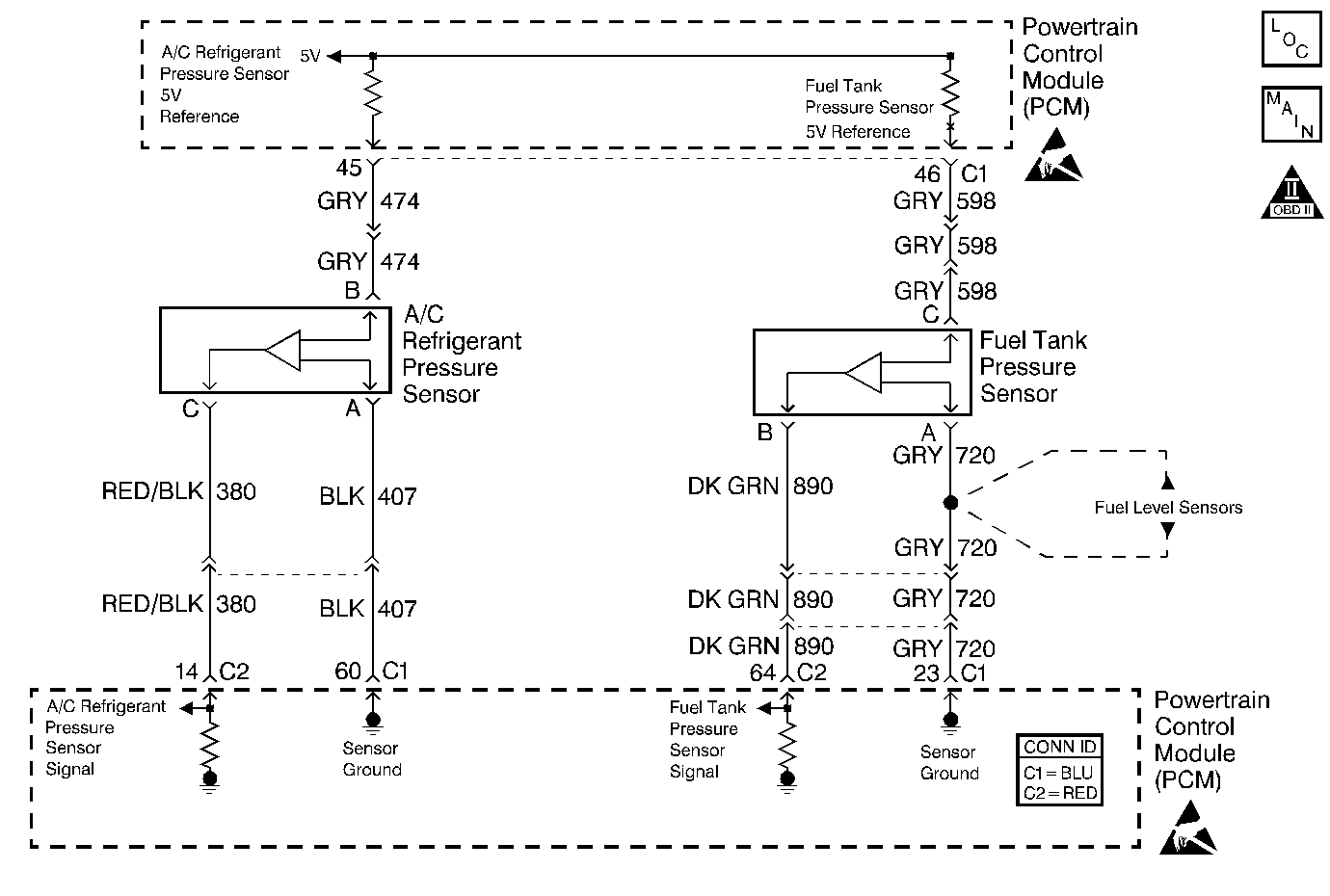
Circuit Description
The A/C system uses an A/C refrigerant pressure sensor mounted in the high side of the A/C system to monitor A/C refrigerant pressure. The PCM utilizes this information in order to disable the A/C compressor clutch when the A/C system pressure is out of range. The PCM also uses A/C refrigerant pressure sensor to enable the engine coolant fans when the A/C refrigerant pressure is high.
The PCM supplies a 5 volt reference, a signal circuit, and a ground circuit to the A/C refrigerant pressure sensor. As the A/C pressure increases or decreases, the resistance of the sensor changes and varies the amount of signal voltage detected by the PCM.
Diagnostic Aids
Important:
• Remove any debris from the PCM connector surfaces before servicing
the PCM. Inspect the PCM connector gaskets when diagnosing/replacing
the modules. Ensure that the gaskets are installed correctly. The
gaskets prevent contaminate intrusion into the PCM. • For any test that requires probing the PCM or a component
harness connector, use the Connector Test Adapter Kit J 35616
. Using this kit prevents damage
to the harness/component terminals. Refer to
Using Connector Test Adapters
in Wiring Systems.
| • | The following may cause an intermittent: |
| - | Poor connections |
| - | Refer to Testing for Intermittent Conditions and Poor Connections in Wiring Systems. |
| - | Mis-routed harness |
| - | Rubbed through wire insulation |
| - | Broken wire inside the insulation |
| • | If the test did not fail this ignition cycle, move the related electrical harnesses and the connectors while monitoring a scan tool. |
| • | Using Freeze Frame and/or Failure Records data may aid in locating an intermittent condition. If you cannot duplicate the DTC, the information included in the Freeze Frame and/or Failure Records data can aid in determining how many miles since the DTC set. The Fail Counter and Pass Counter can also aid determining how many ignition cycles the diagnostic reported a pass and/or a fail. Operate the vehicle within the same freeze frame conditions (RPM, load, vehicle speed, temperature, etc.) that you observed. This isolates when the DTC failed. |
| • | For an intermittent, refer to Symptoms . |
Test Description
The numbers below refer to the step numbers on the diagnostic table.
-
The normal A/C voltage is between 1.0 and 1.8 volts.
-
If the A/C pressure/voltage stays high after disconnecting the A/C refrigerant pressure sensor electrical connector, this indicates the signal circuit is shorted to a voltage.
-
This step tests for a good ground circuit.
-
This step verifies the integrity of the A/C refrigerant pressure sensor signal circuit.
-
If you have thoroughly inspected the 5.0 volt reference circuit (for opens, shorts to ground, PCM connections etc.) and is OK, then replace the PCM.
-
If you have thoroughly inspected the ground circuit for opens and the PCM connections are OK, then replace the PCM.
Step | Action | Values | Yes | No |
|---|---|---|---|---|
1 | Did you perform the Powertrain On-Board Diagnostic (OBD) System Check? | -- | ||
2 |
Did DTC P1639 fail this ignition cycle? | -- | ||
Does the scan tool indicate the A/C High Side Pressure voltage within the specified range? | 0.1-1.8V | |||
4 | Move related harnesses while monitoring the A/C High Pressure voltage. Does the scan tool indicate that the sensor values change while moving related electrical harnesses? | -- | Go to Diagnostic Aids | |
Disconnect the A/C refrigerant pressure sensor electrical connector. Does the scan tool indicate the A/C High Side less than the specified value? | 1V | |||
6 | Measure the voltage from the A/C refrigerant pressure sensor 5 volt reference circuit to the battery ground using the DMM. Is the voltage near the specified value? | 5V | ||
Measure the voltage from the A/C refrigerant pressure sensor 5 volt reference circuit to the sensor ground circuit using the DMM. Is the voltage at the specified value? | 5V | |||
Jumper the 5 volt reference circuit to the A/C refrigerant pressure sensor signal circuit using a fused jumper wire. Does the scan tool indicate the A/C High Side voltage at the specified value? | 5V | |||
9 | Repair the faulty A/C refrigerant pressure sensor connection or faulty sensor. Refer to Air Conditioning (A/C) Refrigerant Pressure Sensor Replacement in HVAC Systems with A/C-Manual or Automatic. Is the action complete? | -- | System OK | -- |
10 | Repair the short to voltage in the A/C refrigerant pressure sensor signal circuit. Refer to Wiring Repairs in Wiring Systems. Is the action complete? | -- | System OK | -- |
Repair the A/C refrigerant pressure sensor 5 volt reference circuit . Refer to Wiring Repairs in Wiring Systems. Did you find and correct the condition? | -- | System OK | ||
Repair the A/C refrigerant pressure sensor ground circuit. Refer to Wiring Repairs in Wiring Systems. Did you find and correct the condition? | -- | System OK | ||
13 | Repair the A/C refrigerant pressure sensor signal circuit . Refer to Wiring Repairs in Wiring Systems. Did you find and correct the condition? | -- | System OK | |
14 |
Is the action complete? | -- | System OK | |
15 |
Important: Program the replacement PCM. Replace the PCM. Refer to Powertrain Control Module Replacement . Replace the PCM. Is the action complete? | -- | System OK | -- |
16 |
Is the action complete? | -- | System OK | -- |
